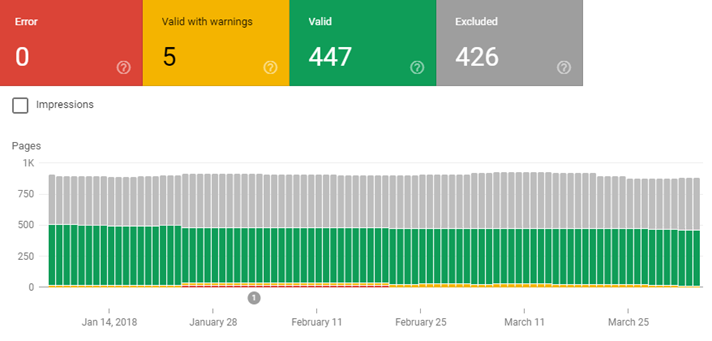
A few months ago, Google rolled out a new Search Console with plenty of new features for webmasters to explore. In this post, we’ll specifically be exploring the Index Coverage Status Report and how SEO enthusiasts can use the report to glean plenty of juicy insights into their sites or their clients’ sites.
The Index Coverage Status report shows you which of your pages have been indexed, and how to fix pages that could not be indexed. This includes all pages—not just pages you’ve included on the XML sitemap.

Index coverage report breakdown
On the graph, you can click the categories at the top to see the corresponding categories. As you can see, each page can have one of the following general status classes:
Error: The page has not been indexed due to an error. Look at the error description for more information and how to fix.
Valid, with warnings: This page has been indexed but there are some issues. This may be intentional on your part.
Valid: The page was indexed. Hurray!
Excluded: These pages were intentionally excluded from the index.
Below the graph, you’ll see the Status box. Clicking into each of these rows will show you all the corresponding URLs for that Index status and reason.

An important point here –not all of the reasons you’ll see in the status box will be things that need to be fixed. This report is telling you which of your pages are being indexed or not, and why. In many cases, the URLs are being crawled and indexed exactly as expected – Google is trying to ensure that you are aware of what URLs Google is seeing and what issues are being found.
Once you go through the messages and fix any issues, you’ll need to validate the fixes to signal to Google the issues have been resolved.
If there are no issues after all the URLs have been checked the Validation will change to Passed. During the validation process, the URL list will update with each URLs status.
Best Practices for the Index Coverage Report
-Check the report for any large increases or decreases within URLs.
-Make sure the URLs provided for each reason are correctly being indexed.
-Crawl any URLs to make sure there are no redirect chains and the end URL is correct.
--
Any questions? Our team is here to help. Contact us and ask away!
